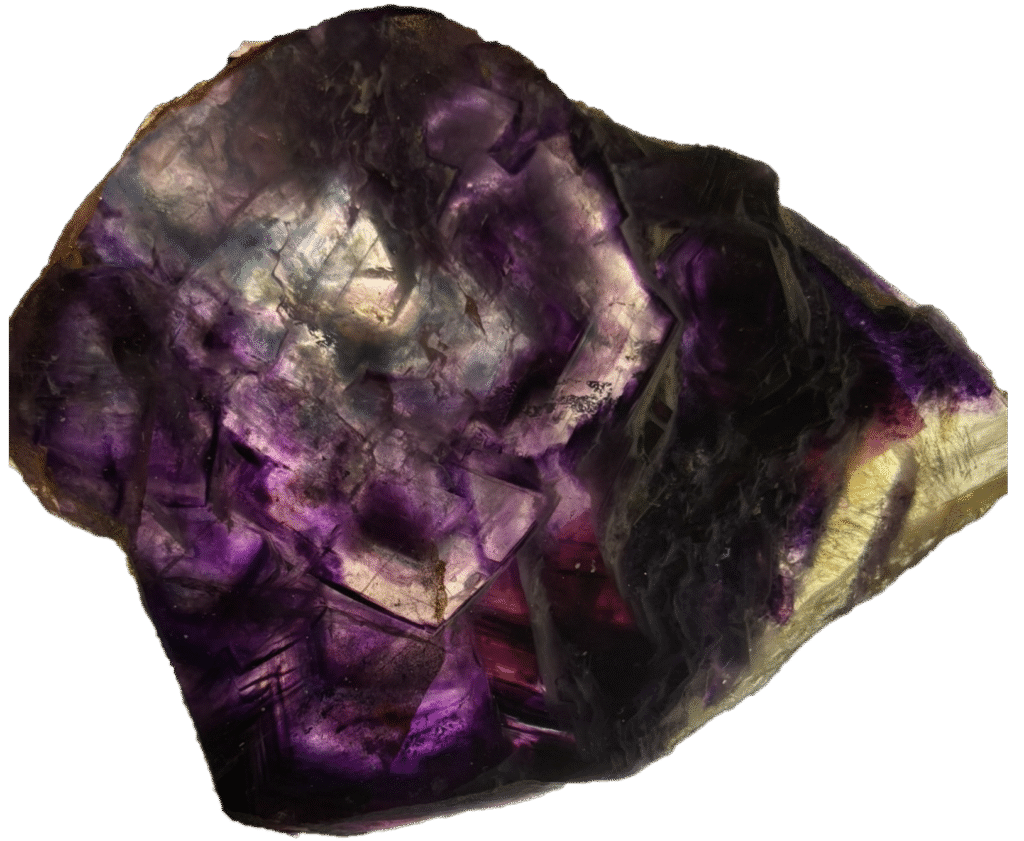
The term “Rainbow Fluorite” stems from the Latin fluere, signifying “to flow”. The term flux comes from the Latin adjective fluxus, meaning flowing, loose, slack. The mineral is used as a flux in iron smelting to decrease the viscosity of slag. Historically, the mineral has been known simply as fluorite, while its multi-hued manifestations have earned it the descriptive title “rainbow”. Such nomenclature has persisted over centuries, thus reinforcing its identity within both scientific and cultural contexts.
Composition and Physical Characteristics
Chemically, Rainbow Fluorite is a compound of calcium fluoride, which may incorporate minor impurities that result in an impressive spectrum of colours. The crystalline structure typically manifests in cubic and octahedral forms, yielding a gemstone that exhibits colours ranging from deep purples and blues to greens, yellows, and reds. Furthermore, its optical clarity and moderate hardness have made it a favoured choice in decorative arts and jewellery, while its unique refractive qualities continue to intrigue researchers.
Varieties and Global Locations
Rainbow Fluorite is found in a variety of geological environments, including hydrothermal veins and sedimentary deposits. Notably, significant deposits are documented in China, England, the United States, and Germany. These diverse localities contribute to the mineral’s varied hues and structural intricacies, thereby ensuring its consistent prominence in both commercial and academic circles. Consequently, the gem’s accessibility across continents has spurred ongoing interest in its study and collection.
One of the most famous of the older-known localities of fluorite is Castleton in Derbyshire, England, where, under the name of “Derbyshire Blue John”, purple-blue fluorite was extracted from several mines or caves. More information on Blue John is in my post Blue John
Archaeological and Historical Usage
Archaeological discoveries have revealed that ancient civilisations prized Rainbow Fluorite for both decorative and ritualistic purposes. Historical records detail its incorporation into ceremonial artefacts and regalia, underscoring its longstanding significance. Today, Rainbow Fluorite continues to influence modern jewellery design and interior decoration, bridging its ancient heritage with contemporary aesthetic sensibilities.
In archaeology, gemmology, classical studies, and Egyptology, the Latin terms murrina and myrrhina refer to fluorite. In book 37 of his Naturalis Historia, Pliny the Elder describes it as a precious stone with purple and white mottling, and noted that the Romans prized objects carved from it.
Folklore, Legends and Interesting Anecdotes
Numerous cultures have woven Rainbow Fluorite into their folklore, attributing to it properties of clarity, transformation, and protection. Local legends recount that ancient healers employed the stone to enhance mental acuity and facilitate spiritual insight. Moreover, tales of mystical realms and the bridging of physical and metaphysical domains abound, thereby amplifying the gem’s allure. Such narratives persist in modern lore, ensuring that Rainbow Fluorite retains its mystical reputation.
Mystical Healing Properties and Spiritual Associations
Rainbow Fluorite is celebrated within alternative healing circles for its purported ability to cleanse the aura and balance energies. Practitioners assert that the gemstone enhances concentration, dispels negative emotions, and promotes mental clarity. In addition, its reputed capacity to stimulate healing processes has made it an essential component of various therapeutic practices. Consequently, the gem is frequently incorporated into meditation rituals and energy-healing sessions.
Astrological and Zodiac Links
In astrological contexts, Rainbow Fluorite is mostly associated with the zodiac signs of Gemini and Virgo. Its energetic qualities are believed to harmonise with the traits of adaptability and analytical thought, thereby reinforcing personal growth and cosmic alignment. Furthermore, enthusiasts claim that the gem augments its wearer’s intuitive capabilities, thus deepening the connection between celestial influences and individual energies.
The Chakra System and Energetic Benefits
Within the framework of the chakra system, Rainbow Fluorite cleanses all the chakras but is primarily linked to the crown and third-eye chakras. These energy centres are integral to spiritual enlightenment and mental clarity. Regular meditation with the gemstone is believed to foster balance, dispel blockages, and facilitate a profound sense of inner peace. Therefore, its use in chakra therapies remains a popular method for achieving energetic harmony.
Additionally,
Clear Fluorite is associated with the Crown Chakra ensures alignment of all chakras.
Blue Fluorite is used with the Throat Chakra to help communicate,
Green Fluorite is linked with the Heart Chakra to balance emotions and growth.
Purple Fluorite works with the Third Eye Chakra to develop intuition, awareness and understanding
Birthstone and Wedding Anniversary Relevance
Although not traditionally recognised as a primary birthstone, Rainbow Fluorite has gained popularity as an alternative for those seeking a unique personal talisman. Additionally, the gemstone is occasionally selected as a wedding anniversary gift, symbolising the multifaceted beauty of love and the enduring nature of partnership. Its dual significance in personal and relational contexts enhances its appeal as both a meaningful and stylish emblem.
